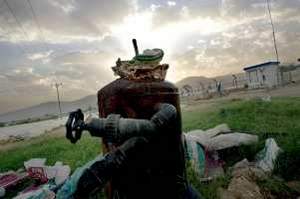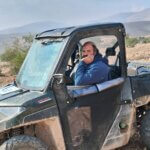The National: Israelis cut water supply to a trickle
Omar Karmi, Foreign Correspondent
JIFTLIK, THE JORDAN VALLEY // Hussein Aidi pointed to a black rubber irrigation pipe from which a few drops of water were leaking.
“The water is running now,” he said, cupping a hand over his ear. “Listen. That water comes from wells at the foot of the hills. Without it, all this wouldn’t be here.”
He swept a hand behind him, indicating the fields there, some 7,000 dunams (700 hectares) of agricultural land belonging to the Jiftlik village that runs from the border with Jordan and up to a main road that separates it from the village. A handful of peasants were working the land, bent over crops, most of them vegetables from cucumbers to cauliflower.

The village has 17 wells, Mr Aidi, 47, explained. But one has dried up and water levels in the others are down as far as two metres from last year. Jiftlik used to draw water from a nearby spring, Ein Shibley, but with droughts and the lack of rainfall, not only is the spring running dry, more villages are using it.
“There is very little water,” said Mr Aidi, himself a farmer. To secure more water, he said, the wells have to be dug deeper. But that would require permission from Israel, permission that is not forthcoming.
“The Israelis control the water,” Mr Aidi said. “Their farmers can use as much water as they like. But they won’t allow us to dig deeper wells, and any water they give us is very restricted.”
Jiftlik lies in Area C of the Jordan Valley, meaning it is under full Israeli civil and military control. About 45 per cent of the occupied West Bank is designated Area C, but the water shortages suffered by Jiftlik and villages like it are not confined to just this area.
On Tuesday, Amnesty International published a comprehensive report on water usage in Israel and the occupied territories in which it said Israel restricts Palestinian access to water by maintaining full control over shared water resources and implementing an allocation policy that “discriminates against the Palestinian population”.
Amnesty found that Israelis consume four times more water than Palestinians and in some cases, notably in settlements, as much as 20 times more water than in nearby rural villages, such as Jiftlik, in which inhabitants survive on barely 20 litres a day. On average, Palestinians in the West Bank and Gaza consume about 70 litres a day, the lowest quantity in the region.
“The core issue is control over water resources and how Israel exercises that control to restrict access water for Palestinians,” said Donatella Rovera, the author of the Amnesty report. “There isn’t a lot of water, but there is water, and it should be divided in a more equitable manner. It is a shared resource that belongs to both Israelis and Palestinians.”
Israeli officials have refuted the report as inaccurate and questioned the methodology, accusing the rights group of ignoring Israeli statistics even though the report is liberally sprinkled with data from the Israeli water authority as well as the Hydrological Service of Israel, described in the report as the most authoritative source.
The Israeli foreign ministry also said Israel was abiding by the Oslo agreement’s provision on water, even providing the Palestinian people with more water than agreed. Ms Rovera said this was only “partly true”, but that Israel was taking more water than agreed at Oslo and that in any case the accords, signed 16 years ago, were not meant to be in place for so long and do not therefore take into account Palestinian population growth and other socioeconomic factors.
“Oslo has lost standing in international law. It is a political agreement that does not relieve Israel of its obligations under international law as an occupying power,” Ms Rovera said.
In the Gaza Strip where the problem is most acute, almost all water is saline and there is no local solution. Either water has to be brought in from outside or a desalination plant must be built. Outside of Gaza, water scarcity is mostly felt in rural communities like that of Jiftlik, according to Amnesty International.
The village’s 3,000 residents, who almost all live off the land, mostly reside in small dwellings with corrugated iron roofs that have no electricity or running water. The village collectively receives a small allocation of drinking water from the same reservoir as three nearby Jewish settlements.That allocation is hugely restricted through an extra-narrow pipeline, Mr Aidi said. Residents have to share what is available. For non-human purposes, the water is brought in on tanks.
Hussein Abed Heileh, 40, spends an hour every three days to fetch a tank filled with water for his herd of 150 sheep. Qais Nasasra, also 40, has to fill buckets of water for his chickens from the roof of a municipal water collection point.
All of that, Mr Aidi said, would be bearable if only there was enough water for the land. But that is not the case, and without the necessary infrastructure to bring water to the village nor the ability to dig deeper wells, the shortage will continue. Mr Aidi said local farmers had sat down to calculate their average income and came to the conclusion that it had sunk as low as five shekels a day (Dh5).
Fifteen families have so far decided to leave the village, a slow trickle making their way to the urban environment of Nablus, the closest city. With the water scarcity, they can no longer survive from agriculture and are forced to leave. Mr Aidi was unequivocal that this was a deliberate strategy by Israel to force the indigenous population to leave.
“Area C is a bit of a special case,” Ms Rovera said. “There are all sorts of efforts going on to induce a reduction in the Palestinian population. And water is a deciding factor in whether these communities can stay where they are.”
For his part, Mr Aidi, a father of five, said he was staying put, but he had stopped cultivating land for himself. Instead, he works in a nearby Jewish settlement, tending a fruit orchard.
“How does that make me feel? Degraded and depressed. But it is the only way I can stay here. If there was more water I would work the land here.
‘But there isn’t. So I work on a settlement for 50 shekels a day.”
See orignial article at www.thenational.ae






